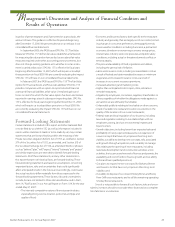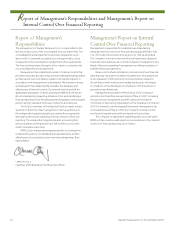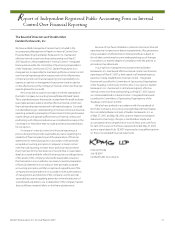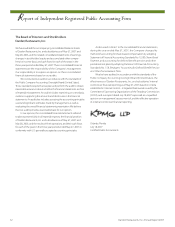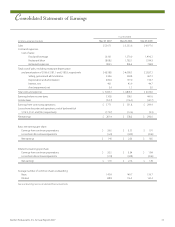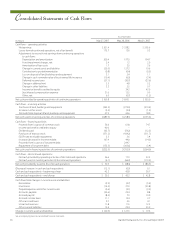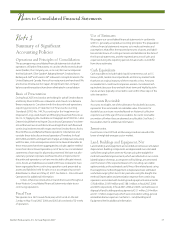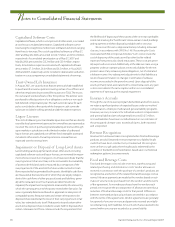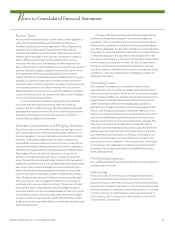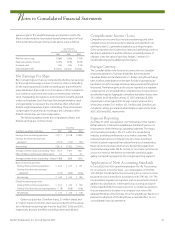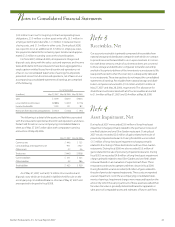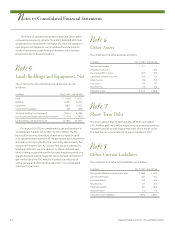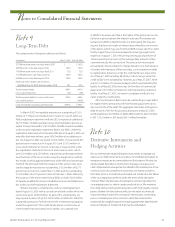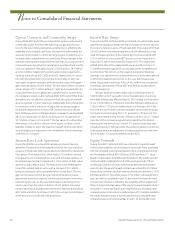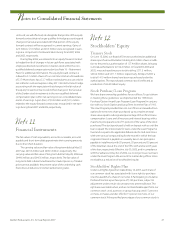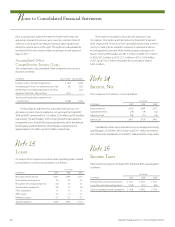Red Lobster 2007 Annual Report Download - page 41
Download and view the complete annual report
Please find page 41 of the 2007 Red Lobster annual report below. You can navigate through the pages in the report by either clicking on the pages listed below, or by using the keyword search tool below to find specific information within the annual report.
N
Darden Restaurants, Inc. Annual Report 2007 39
Notes to Consolidated Financial Statements
Income Taxes
We provide for federal and state income taxes currently payable as
well as for those deferred because of temporary differences
between reporting income and expenses for financial statement
purposes versus tax purposes. Federal income tax credits are
recorded as a reduction of income taxes. Deferred tax assets and
liabilities are recognized for the future tax consequences attribut-
able to differences between the financial statement carrying
amounts of existing assets and liabilities and their respective tax
bases. Deferred tax assets and liabilities are measured using enacted
tax rates expected to apply to taxable income in the years in which
those temporary differences are expected to be recovered or
settled. The effect on deferred tax assets and liabilities of a change in
tax rates is recognized in earnings in the period that includes the
enactment date. Interest recognized in accordance with reserves for
uncertain tax positions is included in interest, net in our consoli-
dated statements of earnings. A corresponding liability is included
in accrued interest, which is a component of other current liabilities
on our consolidated balance sheets.
Income tax benefits credited to equity relate to tax benefits
associated with amounts that are deductible for income tax
purposes but do not affect earnings. These benefits are principally
generated from employee exercises of non-qualified stock options
and vesting of employee restricted stock awards. See Note 15 –
Income Taxes for additional information.
Derivative Instruments and Hedging Activities
We use financial and commodities derivatives to manage interest
rate, compensation and commodities pricing risks inherent in our
business operations. Our use of derivative instruments is currently
limited to interest rate hedges, equity forwards contracts and
commodities futures and options contracts. These instruments are
structured as hedges of forecasted transactions or the variability of
cash flows to be paid related to a recognized asset or liability (cash
flow hedges). We do not enter into derivative instruments for
trading or speculative purposes, however, we have entered into
equity forwards to economically hedge changes in the fair value of
employee investments in our non-qualified deferred compensation
plan and we have not elected hedge accounting for these instru-
ments. All derivatives are recognized on the balance sheet at fair
value. On the date the derivative contract is entered into, we docu-
ment all relationships between hedging instruments and hedged
items, as well as our risk-management objective and strategy for
undertaking the various hedge transactions. This process includes
linking all derivatives designated as cash flow hedges to specific
assets and liabilities on the consolidated balance sheet or to specific
forecasted transactions. We also formally assess, both at the hedge’s
inception and on an ongoing basis, whether the derivatives used in
hedging transactions are highly effective in offsetting changes in cash
flows of hedged items.
Changes in the fair value of derivatives that are highly effective
and that are designated and qualify as cash flow hedges are
recorded in other comprehensive income (loss) until earnings are
affected by the variability in cash flows of the designated hedged
item. Where applicable, we discontinue hedge accounting prospec-
tively when it is determined that the derivative is no longer effective
in offsetting changes in the cash flows of the hedged item or the
derivative is terminated. Any changes in the fair value of a derivative
where hedge accounting has not been elected, has been discon-
tinued or is ineffective are recognized immediately in earnings.
Cash flows related to derivatives are included in operating activities.
See Note 10 – Derivative Instruments and Hedging Activities for
additional information.
Operating Leases
We recognize rent expense on a straight-line basis over the
expected lease term, including cancelable option periods where
failure to exercise the options would result in an economic penalty
to the Company. Differences between amounts paid and amounts
expensed are recorded as deferred rent. Within the provisions of
certain of our leases, there are rent holidays and escalations in
payments over the base lease term, as well as renewal periods. The
effects of the holidays and escalations have been reflected in rent
expense on a straight-line basis over the expected lease term, which
includes cancelable option periods where failure to exercise such
options would result in an economic penalty to the Company. The
lease term commences on the date when we have the right to
control the use of the leased property, which is typically before rent
payments are due under the terms of the lease. Many of our leases
have renewal periods totaling five to 20 years, exercisable at our
option and require payment of property taxes, insurance and
maintenance costs in addition to the rent payments. Percentage
rent expense is generally based on sales levels and is accrued at
the point in time we determine that it is probable that such sales
levels will be achieved.
Pre-Opening Expenses
Non-capital expenditures associated with opening new restaurants
are expensed as incurred.
Advertising
Production costs of commercials are charged to operations
in the fiscal period the advertising is first aired. The costs of
programming and other advertising, promotion and marketing
programs are charged to operations in the fiscal period incurred.
Advertising expense, related to continuing operations, included
in selling, general and administrative expenses, amounted to
$230.0 million, $223.0 million and $206.5 million, in fiscal 2007,
2006 and 2005, respectively.


